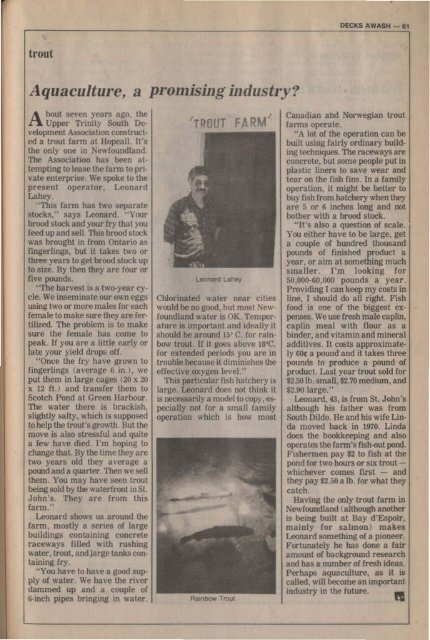Newfoundland - Memorial University's Digital Archives Initiative
Newfoundland - Memorial University's Digital Archives Initiative
Newfoundland - Memorial University's Digital Archives Initiative
You also want an ePaper? Increase the reach of your titles
YUMPU automatically turns print PDFs into web optimized ePapers that Google loves.
OECKS AWASH - 61<br />
trout<br />
Aquaculture, a promisingindustry?<br />
A<br />
bout seven yea rs ago . the<br />
Upper Trinity South Development<br />
Association constructed<br />
a trout farm at Hopeall . It 's<br />
the only one in <strong>Newfoundland</strong>.<br />
The Association has been at <br />
tempting to lease the farm to private<br />
enterprise. We spoke to the<br />
present operator. Leon ard<br />
Lahey.<br />
" This farm has two separate<br />
stocks," says Leonard. "Your<br />
brood stock and your Iry that you<br />
feed.up and sell . This brood stock<br />
was brought in from Ontario as<br />
fingerlings. but it takes two or<br />
three years to get brood stock up<br />
to size. By then they are four or<br />
five pounds.<br />
"The harvest is a two-year cycle.<br />
We inseminate our own eggs<br />
using two or more males for each<br />
female to make sure they are fer <br />
tilized. The problem is to make<br />
sure the female has come to<br />
peak. If you are a little early or<br />
late your yield drops off.<br />
"Once the fry have grown to<br />
fingerlings (average 6 in.), we<br />
put them in large cages (20 x 20<br />
x 12 It.) and transfer them to<br />
Scotch Pond at Green Harbour.<br />
The water there is brackish,<br />
slightly salty, which is supposed<br />
to help the trout's growth. But the<br />
move is also stressful and quite<br />
a few have died . I'm hoping to<br />
change that. By the time they are<br />
two years old they average a<br />
pound and a quarter. Then we sell<br />
them. You may have seen trout<br />
being sold by the waterfront inSt.<br />
John's . They are from thi s<br />
farm."<br />
Leonard shows us around the<br />
farm , mostly a series of large<br />
buildings containing concrete<br />
raceways fiIJed with rushing<br />
water, trout , and large tanks containing<br />
fry.<br />
"You have to have a good supply<br />
of water. We have the river<br />
dammed up and a couple of<br />
6-inch pipes bringing in water.<br />
:TROUT<br />
Leonard Lahey<br />
FARM:<br />
Chlorinated water near citie s<br />
would beno good, but most <strong>Newfoundland</strong><br />
water is OK. Temperature<br />
is important and ideall y it<br />
should be around 15° C. for rainbow<br />
trout. If it goes above ia-C.<br />
for extended periods you are in<br />
trouble because it diminishes the<br />
effective oxygen level. "<br />
This particular fish hatchery is<br />
large. Leonard does not think it<br />
is necessarily a model to copy, especially<br />
not for a small family<br />
operation which is how most<br />
Rambow Trout<br />
Canadian and Norwegian trout<br />
farms operate.<br />
..A lot of the operation can be<br />
built using fairly ordinary building<br />
techniques . The raceways are<br />
concrete, but some people put in<br />
plastic liners to save wear and<br />
tear on the fish fins. In a family<br />
operation, it might be better to<br />
buy fish from hatchery when they<br />
are 5 or 6 inches long and not<br />
bother with a brood stock.<br />
"It's also a question of scale.<br />
You either have to be large, get<br />
a couple or hundred thousand<br />
pounds of finished product a<br />
year, or aim at something much<br />
smaller. I'm looking for<br />
50,000-60,000 pounds a year.<br />
Providing I can keep my costs in<br />
line, I should do all right. Fish<br />
food is one of the biggest expenses.<br />
We use fresh male caplin,<br />
caplin meal with flour as a<br />
binder, and vitamin and mineral<br />
additives. It costs approximately<br />
GO¢: a pound and it takes three<br />
pounds to produce a pound of<br />
product. Last year trout sold for<br />
$2.50lb. small, $2.70medium, and<br />
$2.90 large."<br />
Leonard, 43, is from St. John's<br />
although his father was from<br />
South Dildo. He and his wife Linda<br />
moved back in 1970. Linda<br />
does the bookkeeping and also<br />
operates the fann's fish-outpond.<br />
Fishermen pay $2 to fish at the<br />
pond for two hours or six troutwhichever<br />
comes first - and<br />
they pay $2.50a lb. for what they<br />
catch.<br />
Havtng the only trout farm in<br />
<strong>Newfoundland</strong> (although another<br />
is being built at Bay d'Espoir,<br />
mainly for salmon) makes<br />
Leonard something of a pioneer.<br />
Fortunately he has done a fair<br />
amount of background research<br />
and has a number of fresh ideas.<br />
Perhaps aquaculture, as it is<br />
called , will become an important<br />
industry in the future.
















